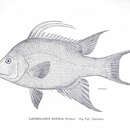Biology
(
англиски
)
добавил Arkive
Hogfish have a fascinating life history; they are protogynous hermaphrodites, meaning that individuals first function sexually as females and then later, upon reaching a larger size, transform into males (4). This change generally occurs at around three years of age and a length of about 35 centimetres (4). Hogfish form harems; groups of females dominated by a larger male. The male and the females simultaneously release gametes into the surrounding water where fertilization occurs. The fertilized eggs develop quickly into larvae, a stage which lasts several weeks until they grow into juveniles. Off the coast of Florida, this spawning event occurs during February and March (4).
Hogfish forage during the day, feeding primarily on gastropods and bivalve molluscs, but also on crabs, sea urchins, and barnacles (2). It can use its long snout and protractible mouth to root in the sand for its favoured prey (3). Hogfish may live for up to 11 years (4).
Conservation
(
англиски
)
добавил Arkive
An assessment of the Florida stock led to the recommendation that the minimum size limit of hogfish that are captured in fisheries should be raised (5), which would reduce the pressure on the Florida stock. There have also been successful attempts at raising hogfish in captivity, and it is hoped that aquaculture will eventually reduce the fishing pressure on natural stocks of this intriguing fish (4).
Description
(
англиски
)
добавил Arkive
The hogfish gets its unusual name from its long, pig-like snout and protrusible mouth which it uses to root around the sea bottom for food (3) (4). The hogfish belongs to the second largest family of marine fishes, the wrasses, but instead of a cigar-shaped body like most wrasses, the hogfish is laterally compressed and round (2) (4). The colour of the hogfish is highly variable, and depends on age, sex and habitat (4). Generally they are pearly white and mottled with reddish-brown (4). Small hogfish may be uniformly grey, whilst large hogfish can be mostly salmon pink, with a dark maroon bar on top of the snout (2). Most individuals possess a prominent round, black blotch below the dorsal fin, yellowish pectoral fins and bright red eyes (2).
Habitat
(
англиски
)
добавил Arkive
The hogfish inhabits inshore patch reefs and seaward reefs, at depths of 3 to 30 meters. It prefers areas with abundant growth of gorgonian corals (3).
Range
(
англиски
)
добавил Arkive
Occurs in the western Atlantic, from North Carolina and Bermuda, south to the Gulf of Mexico and the northern coast of South America (2).
Status
(
англиски
)
добавил Arkive
Classified as Vulnerable (VU) on the IUCN Red List 2007 (1).
Threats
(
англиски
)
добавил Arkive
Hogfish are sought after by humans (2), due to their apparently unique taste and flavour (5). Unfortunately, this has led to fishing pressure that has reduced many populations to critically low levels (5), and the hogfish is now vulnerable to extinction (1). In Florida, where the fish is economically important to both commercial and recreational fisheries, there are indications that the hogfish stock has been overfished for more than a decade (5). Juvenile hogfish are also sometimes captured for the aquarium trade (2).

